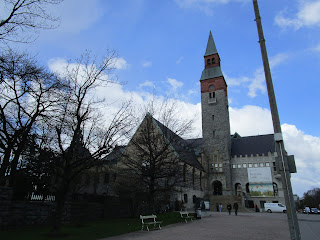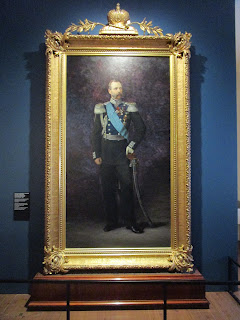 |
| Inside Helsinki's Temppeliaukion Church, a church carved out of solid granite. |
The next stop on my walking trek through the tourist core of Helsinki is the National Museum.
Let's go in and have a look and maybe learn something about the history of Finland from its National Museum. A stone bear guards the front door.
And the doors are nicely carved.
The entrance way, unfortunately, was the most interesting part of the museum. This was the most useless national museum in which I have ever toured. Sorry. It does an exceedingly poor job of presenting this unique, interesting country to its citizens and tourists.
Take for example the section on the country's religious art.
Rather than simply presenting from where in the country the pieces were found, and placing the various pieces in the context of the development of western art -- which the Swedish history museum did an outstanding job of doing, the Finnish museum instead, in its display cards, mocks Christian religious belief as yet another baseless superstitition of a primitive people inferior to us modern sophisticates.
It is one thing to think this. In a pluralistic society, one certainly has the right to have this belief. But this is a national museum. I would have expected more respect for -- what's the word? -- diversity.
Sweden is probably no more or less "Christian" than is Finland. And the curators of that museum are probably no more or less devout in their beliefs. Yet Sweden's museum presented religious art simply as art in the context of western art. It is the only way to present this legitimate and beautiful artistic tradition in a way that respects the religious beliefs, or non-beliefs, of the diverse multitude who attend the museum. In this light. Sweden succeeded and Finland failed.
There was a small display related to Finland's czarist history. This is Czar Alexander II, Emperor of Russia and Grand Duke of Finland:
Finland never had a royal family per se. They were either ruled by the Swedish King or the Russian Czar. Finnish independence is a relatively recent phenomenon.
Here is Czar Alexander's throne:
And that is the greatest failing of this museum. Finland has an extraordinary story to tell. You have these people who ended up in an empty corner of in the far, far north of continental Europe. They speak an idiosyncratic language unrelated to most of their European brethren (although it is somewhat, but distantly, related to Hungarian). They were ruled from afar for most of their history. They fought for independence at the end of World War I. They fought to maintain independence from the Soviet Union in World War II. They survived a national emasculation known as "Finlandization" during the Cold War years. The ethnically-unrelated Sami people (we used to call them the Lapps, but the name changed) live in the far, far north, generally unknown to the rest of the world until Santa Claus-based tourism became a thing in the latter 20th Century. Yet this small country of five and a half million people has survived and prospered into the 21st Century.

Why? You will not find any clues to the answer to your question in Finland's superfluous national museum. So let's leave it behind in search of worthier destinations.
Such as the nearby Temppeliaukion Church:
This is a church carved out from solid granite.
I think it's non-denominational. I believe it is not even officially Christian.
The altar set-up looks like it was done in a Christian style, but it's missing some key elements. Such as a crucifix. I don't think I saw a single cross in here. But it's an architectural marvel.
As is this:
And what is that? It's the Kampin kappeli. It is the chapel of contemplation. Go in. Relax. Contemplate. Forget the stresses of the outside world.
It's "temporarily" closed. But even when open, no photography was permitted inside. Photography would interfere with the chapel's contemplative and reflective mission. It actually would, if I am being honest (and I am).
Yet another interesting looking older building on my walk back to my hotel.
And finally I am back on Bulevardi, the Boulevard.
It's my birthday, so I decided to go someplace "special" for my birthday dinner. I chose Muru. It had the twin advantages of being only a block from my hotel and being much cheaper than the other "fine dining" options in town.
I had the four-course fixed price menu.
I ordered a burger. And they served it RAW! Well, actually, as you sophisticated people already know, that was steak tartare -- a.k.a., cow sushi -- it's supposed to be that way. It was tender and the mustard-seed based sauce was quite good. It came served with a complementary. "Complementary" with an "e," meaning it complemented the main dish. Not "complimentary" with an "i," as in free of charge. It was a German red. I remember no other details even though the sommelier explained them in detail. Too much detail for a wine dilettante like me.
The next course was the main course, a fish course.
I don't know the species of the fish. It was locally caught in the Baltic. That's all I know. The lemon cream sauce on the side was to die for. To. Die. For. This was paired with a German white wine. A chardonnay, not a riesling.
The third course was a cheese course. It was good, but how photogenic is sliced cheese? It was paired with a Port. Let's move on to dessert.
A licorice panna cotta and a passionfruit sorbet. I'm not a fan of black licorice, but this dessert worked. The licorice was mild enough to complement the panna cotta and not overpower it. This was paired with a white Sicilian dessert wine of some sort. Not a marsala. I would've remembered that. Some other Sicilian white wine.
That was my day's walking tour. That was my birthday dinner.























No comments:
Post a Comment